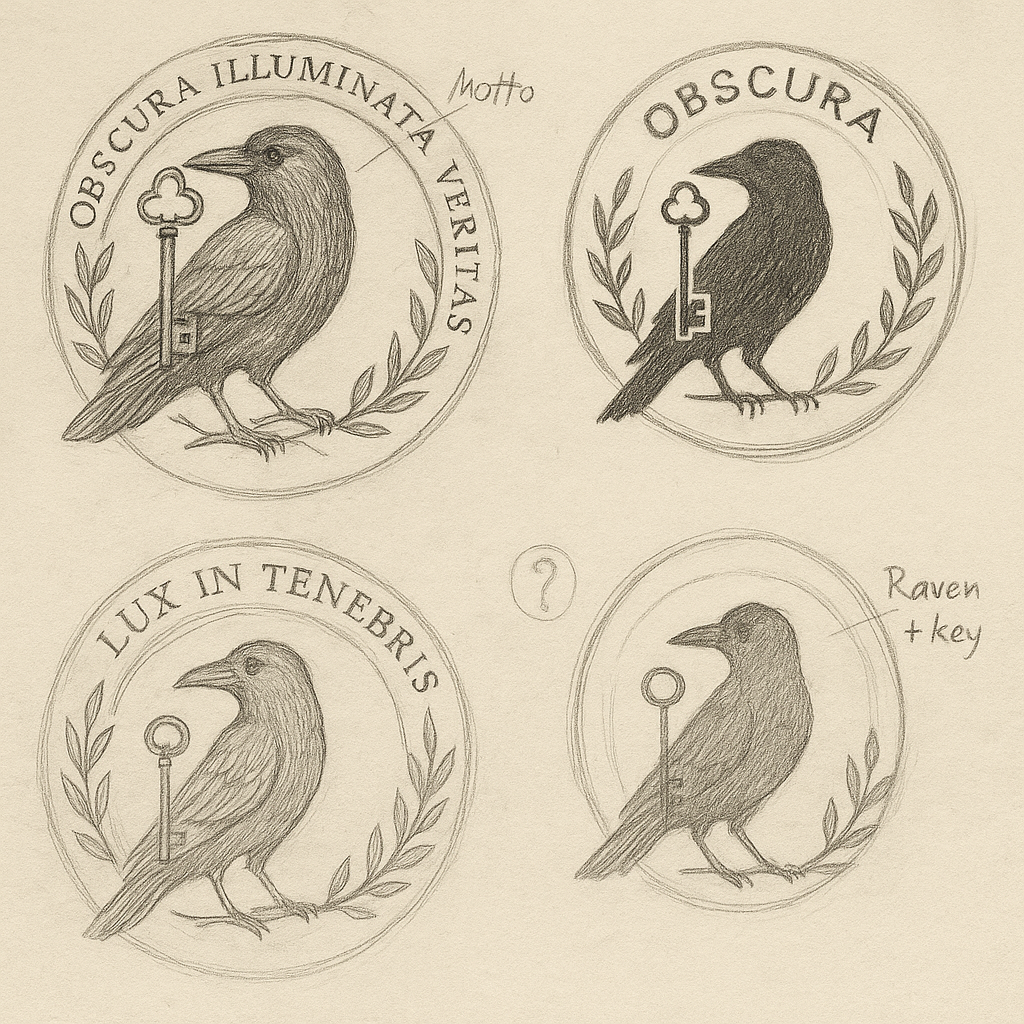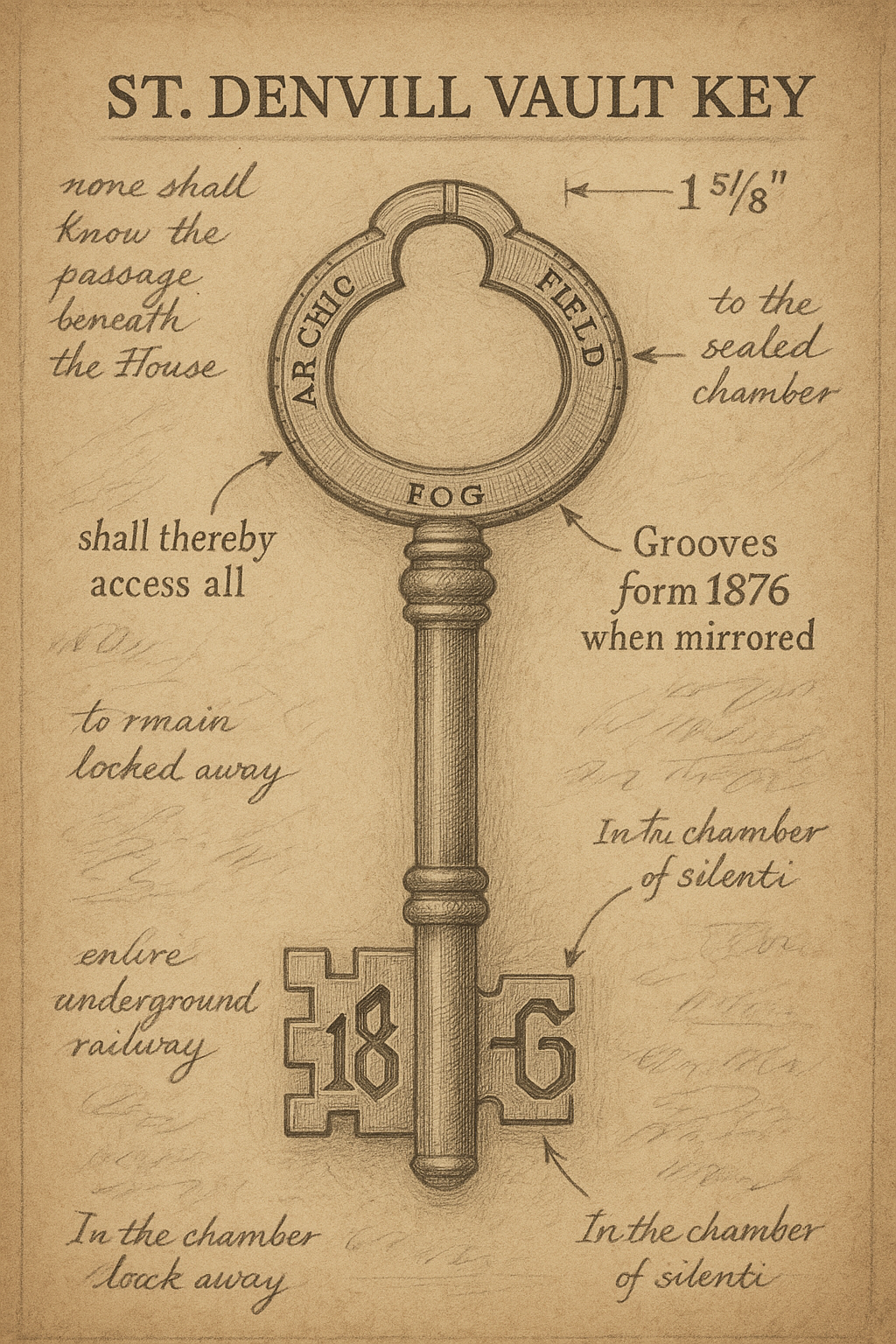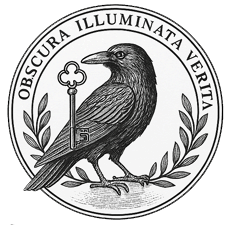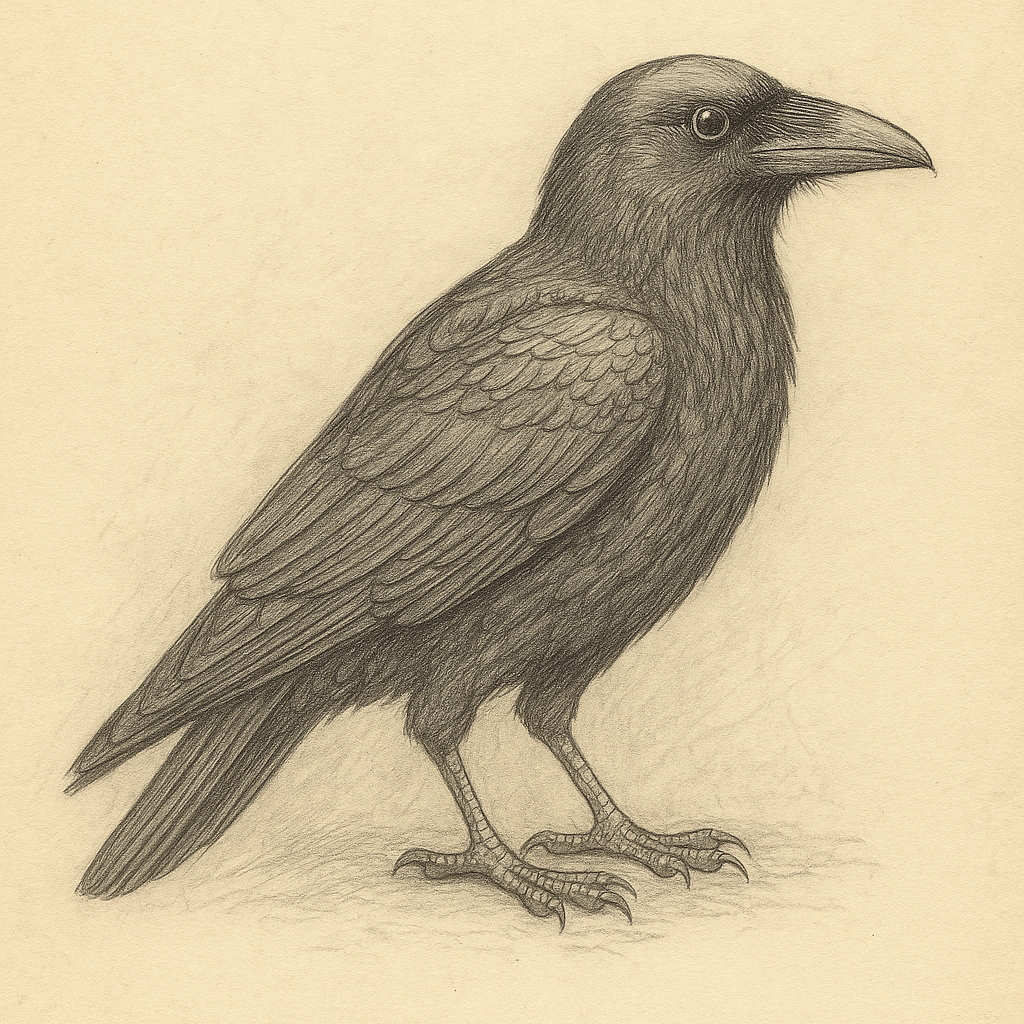 Hidden Meaning, History, and Legacy
Hidden Meaning, History, and Legacy
Overview
The official StormCroft emblem — a raven clutching a skeleton key, framed by laurel branches and a Latin motto — is far more than a mere decorative logo or institutional crest.
It serves as a symbolic seal, an encoded declaration of purpose for the StormCroft Institute’s most secretive operations, its esoteric philosophies, and its unwavering pursuit of knowledge that many deem too dangerous or too unnatural to be studied. Every element in the emblem is layered with meaning, pointing toward the Institute’s deep and deliberate entanglement with the forbidden, the obscured, and the unexplained — truths that linger just beyond the reach of accepted science or orthodox thought.
This is not just a design — it is a warning, a record, and a vow.
Design Origins

A collection of early design drafts by Thaddeus Pell for what would become the official StormCroft emblem.
The emblem was first conceived in November 1884 by Thaddeus Pell, an architectural draughtsman and occult symbologist working within the StormCroft estate during its Obscura Phase — a period marked by rapid expansion of its psychological and metaphysical divisions.
(image: These pencil sketches, drawn on archival parchment in late 1884, explore variations of the raven-and-key motif surrounded by laurel branches. Handwritten notes question motto placement, visual weight, and symbolism. Early alternatives include the phrase “Lux in Tenebris” (“Light in Darkness”) before settling on the now iconic “Obscura Illuminata Veritas.” These studies reveal Pell’s obsessive attention to balance, secrecy, and semiotic layering — traits that became hallmarks of the House’s visual language).
Pell was originally hired to assist in redrawing underground tunnel blueprints but soon earned the trust of Director Octavius Wren. Wren commissioned Pell to create a mark that would silently reflect StormCroft’s mission without revealing anything directly to outsiders. The logo was carved into the wrought iron gates of the West Wing in 1886, and has remained unchanged since.
The Raven
The raven represents far more than a bird — it is the very embodiment of observation, secrecy, and cognitive manipulation. Its presence in the emblem is deliberate, chosen not for superstition, but for its natural affinity with memory, mimicry, and the unseen. Native to the StormCroft moorlands, these intelligent corvids were often seen circling above the estate or perched silently along the outer walls during sensitive operations. Within the Institute’s internal folklore, the raven was considered a familiar or scout, its keen eyes and cryptic calls linked to the silent guardianship of StormCroft agents.
Symbolically, the raven represents the House’s ability to outlive time, to observe without being observed, and to hide in plain sight — a theme echoed across many StormCroft texts and protocols.
In the unpublished notebooks of Elias Horne, ravens were reportedly able to mimic human speech with uncanny clarity inside Chamber F3, a soundproofed corridor where language distortion experiments were conducted. This behaviour was initially dismissed as hallucination or echo effect until spectral waveform mapping linked the phenomena to auditory anomalies triggered by Fog Transport resonance fields. Some researchers believed the ravens were not merely mimicking — they were relaying.
The Skeleton Key

The key is the most potent symbol: a literal and metaphorical unlocker of doors. It opens passageways (many not physical) and is an exact rendering of the original “St. Denvill Vault Key”, a master key said to access every chamber beneath the estate, including the now-sealed Room Æther.
The key’s design hides a cipher:
-
The grooves form “1876” if rotated and mirrored.
-
Its bow contains four notches that correlate with StormCroft’s internal divisions: Archive, Field, Fog, and Reflection.
(image: This annotated design sketch of the legendary St. Denvill Vault Key was recovered from Thaddeus Pell’s workshop journals, circa late 1884. Crafted in graphite on aged vellum, the illustration reveals the meticulous detailing behind StormCroft’s most guarded artefact.
The circular bow features four notches representing the House’s internal divisions — Archive, Field, Fog, and Reflection. The bit grooves, when mirrored, reveal the number “1876”, a date linked to the first recorded deposit into the Langport Weighhouse.
Marginal notes scrawled in Pell’s hand hint at the key’s wider utility — granting access not only to sealed chambers beneath StormCroft House, but to Room Æther and the entire underground railway. Repeated phrases such as “In the chamber of silenti” and “none shall know the passage beneath the House” suggest a ceremonial, perhaps even ritualistic, significance.
An enduring symbol of StormCroft’s deepest mysteries, this key is as much a cipher as it is a tool).
Laurel Branches

This delicate pencil sketch depicts the twin laurel branches later adopted into the official StormCroft emblem.
Traditionally symbols of victory, the laurel branches here represent restraint. Knowledge at StormCroft is not celebrated, but bound. The branches are said to have been modeled after those from the Clairmont Grove, a thicket where 14 patients disappeared in 1923 during a lucid ritual.
Motto: OBSCURA ILLUMINATA VERITAS
Translated: “In Darkness, Truth Is Illuminated.”
It is intentionally paradoxical — suggesting that truth at StormCroft is found not in light, but in obscurity. The Institute believes that trauma, anomaly, and the fringes of consciousness are where true understanding begins.
(image: While laurel has long symbolised triumph, these branches — said to be based on those found in Clairmont Grove — represent the containment of knowledge rather than its celebration.
The drawing, believed to be part of Thaddeus Pell’s original emblem folio, reflects a disciplined symmetry and restraint in composition. The branches are visually pristine, yet their lore is anything but: the Grove from which they were modeled was the site of the 1923 lucid ritual incident, during which 14 patients vanished without trace. That event became central to the Institute’s doctrine on metaphysical exposure.
These laurels remain a symbol of solemn mastery, whispering a truth long held at StormCroft — that some knowledge is not meant to be known, only kept).
Tattoo & Character Lore
Jonathan Hales — Kitchen Porter
Ethnicity: Black
Age During Service: 17
Years Active: 1887–1889

Though young and in a junior role, Jonathan Hales was admired throughout the House for his wit, discretion, and loyalty. He was one of only a handful of domestic staff permitted access to the Sub-Basement East during the testing of early Fog Transport technology.
Following an accident involving a ruptured field in late 1888, Hales experienced what was later documented as an intuitive synchronisation — a brief psychic alignment with an unknown observer entity.
Shortly before his departure in 1889, Hales had the full StormCroft emblem tattooed on the inside of his left thigh, hidden from all but the most intimate view.
“If the House forgets me, my skin won’t.” — Jonathan Hales, personal letter left in the laundry annexe
The tattoo was done by a transient inkworker known only as Ninefold, using a fog-carbon blend said to glow faintly when submerged in silence. Hales’ tattoo was the first ever recorded — preceding the later Field Division marks by decades.
(image: This refined blackwork tattoo, inked on medium-brown skin, represents the earliest known human inscription of the StormCroft emblem. Belonging to Jonathan Hales, a 17-year-old kitchen porter active from 1887–1889, the design features a raven clutching a skeleton key, encircled by laurel branches and the House’s solemn motto: OBSCURA ILLUMINATA VERITAS).
The placement of Jonathan Hales’ tattoo required exceptional discretion. The emblem was inked just beneath the scrotum, in a position chosen for both intimacy and concealment. Such a location ensured that the mark would be known only to those closest to Hales — or to those charged with examining the body should it ever be recovered under compromised circumstances.
The inkworker known as Ninefold, a transient artist trusted with certain unorthodox assignments for the Institute, was said to have taken great care and silence during the procedure. The session took place deep within the laundry annexe, well outside the routine patrols of the Night Stewards. Hales had chosen the spot deliberately, stating in a whispered letter:
“I want it where no man looks unless I say so. I’ll carry the House until I drop — and even then, they’ll know who I was.”
Because of the anatomical sensitivity, Ninefold used a modified carbon-blend fog ink, applied with slowed pulse and minimal vibration to reduce trauma and allow for precise detailing. It remains one of the most intimate and symbolically loaded markings ever recorded within StormCroft annals — equal parts loyalty, defiance, and declaration.
During the course of the tattoo’s application, Jonathan Hales became aware that Ninefold, despite his reputation for emotional detachment, had entered a state of visible tension — a mix of physical arousal and ritualistic focus that was not uncommon in high-sensitivity applications involving fog-carbon inks and intimate contact.
Sensing the rising intensity, and perhaps uncomfortable with the unspoken undercurrent, Hales reportedly paused the session and insisted Ninefold excuse himself to a private adjoining space to “manage the moment in silence.” According to a marginal annotation later discovered in Ninefold’s own folio, he did so without protest, returning composed and sharper in line control.
Ironically — and never publicly acknowledged — Hales himself had experienced a similar physical response, though his release was far more discreet. It is believed to have occurred quietly, on the very couch where the mark was being applied, unnoticed in the moment, but noted in Hales’ own unfinished testimonial fragments:
“If the House marks you where no eyes should see, it knows all of you — body, breath, shame, and pride. I let go. I let go everything.”
This episode — rarely discussed — adds yet another layer of complexity to the Hales narrative. The act of tattooing became not only a rite of identity, but a moment of mutual vulnerability, intensified by the secrecy, the placement, and the emotional weight both men carried into that small, lamplit room beneath the South Wing.
According to notes later annotated in the Ninefold Apocrypha, during the final phase of inking, Jonathan Hales, having experienced a quiet physical release of his own, managed to discreetly wipe the residual liquid using the same linen cloth Ninefold had been using to dab away excess ink and fog-carbon from the freshly tattooed skin.
The action was quick, instinctive, and reportedly unspoken between them. The cloth itself — stained with both ink and evidence of bodily response — was folded and left behind without remark. It was later retrieved by a Night Steward and, according to internal ledgers, quietly archived under item number F1879-B within the House’s Undescribed Artefacts drawer, where it remains sealed in wax paper.
The moment is rarely referenced in formal history, but within staff folklore it is cited as a powerful symbol of the merging of duty, vulnerability, and physical embodiment of the House’s influence. Hales did not speak of it again — but in one final scribbled line from his archived linen ledger, he wrote:
“That cloth bore more than ink. It bore the truth of where I stood.”
Hidden Elements
-
The raven’s eye hides a hexagram, only visible under magnification.
-
Its foot rests on a scroll, symbolising control over narrative and truth.
-
When overlaid on the Langport Underground Map, the key aligns with the Denvill Vault entrance.
Final Thoughts
The StormCroft logo is not just a symbol. It is a cipher in plain sight — encoding identity, legacy, and philosophy.
To outsiders: a curious emblem.
To insiders: the first and final key.

